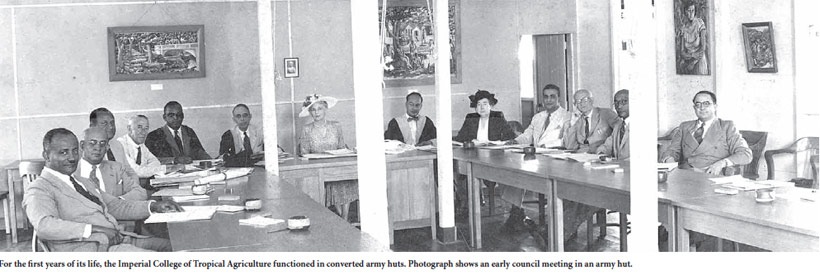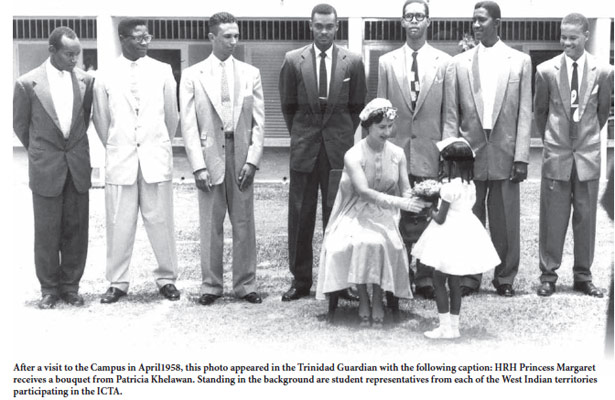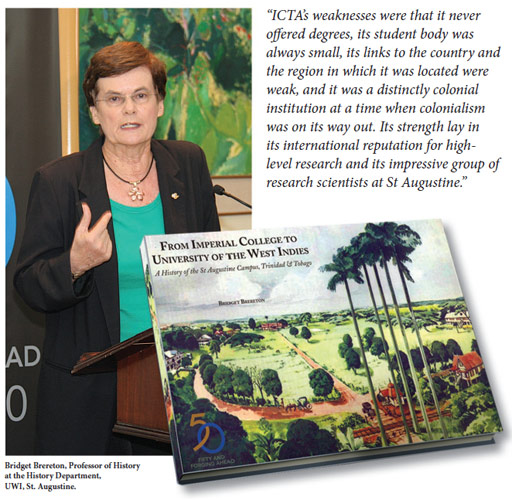|
December 2018

Issue Home >>
|



On October 12, 1960, an impressive ceremony took place at the brand new Queen’s Hall in Port of Spain: the handing over of the Imperial College of Tropical Agriculture (ICTA) to the University College of the West Indies (UCWI.) Present were a veritable Who’s Who of the day: the Governor-General and Prime Minister of the West Indies Federation; the Governor and Premier of Trinidad & Tobago; ministers of both the Federal and the local governments; and, of course, the top officials of UCWI and ICTA.
The speech of the day was by Arthur Lewis, Principal of UCWI, the future first Vice-Chancellor of UWI (1962) and Nobel Prize winner. He described the ‘marriage’ being celebrated as one between a mature lady of forty and a twelve-year-old boy, and advised that the boy must be willing to learn and the lady to be tolerant. This was the union which made St Augustine the second campus of the regional University and launched fifty years of steady growth in tertiary education at this site.
The Imperial College had opened its doors to students in 1922. In its 38 years of operation, it never offered degrees; instead, students (mainly West Indian school-leavers) studied for a Diploma which was roughly equivalent to an undergraduate degree, while others (mostly British) obtained postgraduate qualifications. Its main purpose was to prepare British men for posts in the empire’s agricultural services, and to do research on the cultivation and processing of tropical crops; training young West Indians in agriculture was secondary. By the 1950s ICTA’s student body was very international, with West Indians outnumbered by postgraduates from Britain and from virtually every colony in the tropical empire.
ICTA’s weaknesses were that it never offered degrees, its student body was always small, its links to the country and the region in which it was located were weak, and it was a distinctly colonial institution at a time when colonialism was on its way out. Its strength lay in its international reputation for high-level research and its impressive group of research scientists at St Augustine.
This formed the core of the first Faculty at the new UCWI campus, the Faculty of Agriculture (1960), followed in 1961 by the Faculty of Engineering. Under the leadership of Philip Sherlock and Dudley Huggins in the 1960s, the fledgling campus was transformed as part of the regional University, which gained its ‘independence’ as UWI in 1962. In 1963, undergraduate teaching in the arts, social sciences and natural sciences began under the umbrella of a ‘College of Arts and Sciences’. From a total student body of 67 in 1960, all in the Faculty of Agriculture, the campus had 1270 students in 1969, studying many different subjects and courses.
 During the 1960s, St Augustine was still dominated by the buildings and facilities inherited from ICTA: the Administration Building, the Frank Stockdale Building, and many other structures located in the northern half of the campus. But new structures soon appeared, starting with the first Engineering Block (1962-63) and Canada Hall (1964), the second student residence (Milner has been opened in 1927-28 as ICTA’s student hostel). Trinity Hall, for women, was opened in 1972. Much of the new building in the 1960s was located in the southern half of the campus—the area used as the College Farm in the days of ICTA—and the impressive, if hardly beautiful, structures of the JFK Complex were erected here. By 1968-69 the Complex was occupied, providing much-needed space for teaching in the arts, social sciences and natural sciences, along with a lecture theatre, an auditorium, a cafeteria and student amenities, and—above all—a new Library. From its desperately cramped quarters in the Administration Building, the Main Library, under the inspirational leadership of Alma Jordan, moved to its present location in 1969. It was to undergo two major extensions in the 1980s and 1990s. In the northern area where most of ICTA’s facilities had been taken over by the Faculty of Agriculture, the new Dudley Huggins Building (1969) provided more space for that Faculty. During the 1960s, St Augustine was still dominated by the buildings and facilities inherited from ICTA: the Administration Building, the Frank Stockdale Building, and many other structures located in the northern half of the campus. But new structures soon appeared, starting with the first Engineering Block (1962-63) and Canada Hall (1964), the second student residence (Milner has been opened in 1927-28 as ICTA’s student hostel). Trinity Hall, for women, was opened in 1972. Much of the new building in the 1960s was located in the southern half of the campus—the area used as the College Farm in the days of ICTA—and the impressive, if hardly beautiful, structures of the JFK Complex were erected here. By 1968-69 the Complex was occupied, providing much-needed space for teaching in the arts, social sciences and natural sciences, along with a lecture theatre, an auditorium, a cafeteria and student amenities, and—above all—a new Library. From its desperately cramped quarters in the Administration Building, the Main Library, under the inspirational leadership of Alma Jordan, moved to its present location in 1969. It was to undergo two major extensions in the 1980s and 1990s. In the northern area where most of ICTA’s facilities had been taken over by the Faculty of Agriculture, the new Dudley Huggins Building (1969) provided more space for that Faculty.
In universities all over the world, the late 1960s witnessed considerable political activism by students, and St Augustine was no exception. Indeed, it can be said that between 1968 and 1970, the campus was more at the centre of national events, and more intensely present in the public’s consciousness, than ever before or since. The Rodney Affair, the local repercussions from the Sir George William University events in Montreal, the swiftly developing Black Power Movement, largely led by St Augustine students or recent graduates, the formation of NJAC—all placed the campus at the centre of events. Student leaders like Geddes Granger (Makandal Daaga), Dave D’Arbeau (Khafra Kambon) and others became household names. Several members of the academic staff were prominent in the movement and two were detained during the State of Emergency (1970), along with several students or recent graduates. All in all, 1970 was a tense time for the campus, whatever people’s individual opinions about Black Power.
Political activism on campus waned in the 1970s, and the campus entered another period of expansion, presided over by Lloyd Braithwaite, Principal 1969-84. The College of Arts and Sciences was disbanded and replaced with Faculties of Arts & General Studies, Social Sciences, Natural Sciences, and Education, replicating the structure at Mona, and joining the original Faculties of Agriculture and Engineering. The oil boom (1973-81), coupled with the determination of Prime Minister Eric Williams to create a petrochemicals and heavy industry sector in Trinidad, made possible a spectacular expansion of the Faculty of Engineering, funded by the national government, in the late 1970s and early 1980s. This was the ‘Empire of Engineering’, much envied by less fortunate sections of the campus. The oil boom also funded the huge Mount Hope Medical Complex, and drove the government’s decision to set up a new Faculty of Medical Sciences in Trinidad which would teach dentistry and veterinary science as well as medicine. This was a painful and difficult process; but at last (long after the end of the boom), in 1989, the new Faculty based at Mount Hope opened its doors to students.
 Just like the nation itself, St Augustine has suffered from recurrent periods of ‘boom and bust’. After the heady years of the oil boom, from which the campus benefitted tremendously, a period of hard times set in from the mid-1980s, which lasted more or less a decade. It fell to Principal G.M. Richards (1985-96) to bring the campus through these difficulties. Many new developments had to be put on hold, but the growth in student numbers, and in programme and course offerings, never stopped. By the mid-1990s, the financial situation had improved, and a new era of building and general expansion began, funded in part by massive loans from the IDB, as well as subventions and capital grants from the national government. Important new structures went up in this period of renewed expansion, presided over by Principals Compton Bourne (1996-2001) and Bhoendradatt Tewarie (2001-07), such as the Learning Resource Centre, the Student Activity Centre, the Sport and Physical Education Centre (SPEC), the extensions to the Natural Sciences and Chemistry blocks, the Centre for Language Learning, the Joyce Gibson Innis Hall at Mount Hope, and others. Student numbers increased steadily, and dramatically from about 2001, when the national government first pledged to pay half of all tuition fees for undergraduates, then (2004) a hundred per cent (GATE). Just like the nation itself, St Augustine has suffered from recurrent periods of ‘boom and bust’. After the heady years of the oil boom, from which the campus benefitted tremendously, a period of hard times set in from the mid-1980s, which lasted more or less a decade. It fell to Principal G.M. Richards (1985-96) to bring the campus through these difficulties. Many new developments had to be put on hold, but the growth in student numbers, and in programme and course offerings, never stopped. By the mid-1990s, the financial situation had improved, and a new era of building and general expansion began, funded in part by massive loans from the IDB, as well as subventions and capital grants from the national government. Important new structures went up in this period of renewed expansion, presided over by Principals Compton Bourne (1996-2001) and Bhoendradatt Tewarie (2001-07), such as the Learning Resource Centre, the Student Activity Centre, the Sport and Physical Education Centre (SPEC), the extensions to the Natural Sciences and Chemistry blocks, the Centre for Language Learning, the Joyce Gibson Innis Hall at Mount Hope, and others. Student numbers increased steadily, and dramatically from about 2001, when the national government first pledged to pay half of all tuition fees for undergraduates, then (2004) a hundred per cent (GATE).
Many new programmes, undergraduate and postgraduate, were introduced in this period and some departments or programmes were seriously stretched to accommodate the rapidly rising enrolments. Some developments were not universally welcomed, such as the move to the two-semester system, carried out in the early 1990s; and the decision in 1996 to merge the Faculties of Arts and Education to create the Faculty of Humanities & Education, and the Faculties of Agriculture and Natural Sciences to create what was eventually named the Faculty of Science & Agriculture. This last merger, eliminating the first Faculty to be established at St Augustine, the inheritor of the ICTA tradition, was especially difficult, creating reverberations which exist to this day.
Yet unquestionably the last few years have been an exciting time of expansion—in student numbers, staff, buildings, programmes, support services, centres or institutes—with the campus enjoying another boom period up to the onset of the world-wide depression in 2008. Stresses and strains there inevitably were (and are) but the sense of forward movement was palpable. Impressive new buildings went up, such as the Lloyd Braithwaite Student Administration Building, the Daaga Auditorium, the Sir Arthur Lewis Hall of Residence on St John’s Road, Engineering Block 13, and the still incomplete six-storey Teaching and Learning Complex. While the present financial situation is again difficult, the forward movement is not likely to be reversed, with the continuing support of the national government despite its own challenges, and under the leadership of Principal Clement Sankat (2008) and his team.
As we walk around the campus today, we can read its history in the buildings, trees, green spaces and roads. ICTA’s legacy is strong on the northern side, with the grand old Administration Building (rededicated earlier this year after a thorough refurbishing inside and out) still presiding over the landscape. To the south the JFK Complex and the Main Library, the creation of the 1960s, along with the many and massive Engineering buildings, dominate. The newer structures, erected in the 1990s or later, are to be found everywhere, with the Daaga Auditorium perhaps standing out particularly. Its name recalls our history: On its site, in 1927, the ICTA Dining Hall was opened, a two-storey building with dining facilities and kitchens downstairs, club and recreation rooms upstairs. When St Augustine became a UWI campus, this structure became the Guild Hall, the centre of student activities. In the period of student activism of 1969-70, it was renamed Daaga Hall after an African ex-slave soldier who led a mutiny at St Joseph in 1837. The building was destroyed by fire in 1980, and the present Auditorium stands on the same site. And the history of our campus going back even before the creation of ICTA is recalled by our oldest building: the Principal’s Office, up to 1996 the Principal’s residence, is the original Great House of the St Augustine sugar estate, built in the middle of the nineteenth century.
-Bridget Brereton is a Professor of History at the History Department, UWI, St. Augustine.
|





